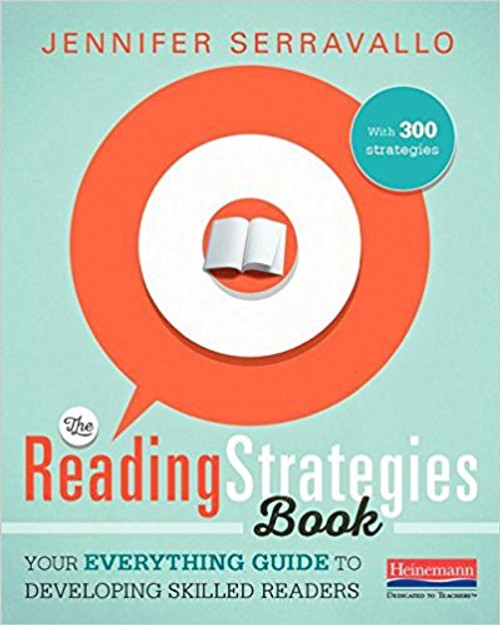Product Description
With hit books that support strategic reading through conferring, small groups, and assessment, Jen Serravallo gets emails almost daily asking, “Isn’t there a book of the strategies themselves?” Now there is.
“Strategies make the often invisible work of reading actionable and visible,” Jen writes. In The Reading Strategies Book, she collects 300 strategies to share with readers in support of thirteen goals—everything from fluency to literary analysis. Each strategy is cross-linked to skills, genres, and Fountas & Pinnell reading levels to give you just-right teaching, just in time. With Jen’s help you’ll:
- develop goals for every reader
- give students step-by-step strategies for skilled reading
- guide readers with prompts aligned to the strategies
- adjust instruction to meet individual needs with Jen’s Teaching Tips
- craft demonstrations and explanations with her Lesson Language
- learn more with Hat Tips to the work of influential teacher-authors.
Whether you use readers workshop, Daily 5/CAFE, guided reading, balanced reading, a core reading program, whole-class novels, or any other approach, The Reading Strategies Book will complement and extend your teaching. Rely on it to plan and implement goal-directed, differentiated instruction for individuals, small groups, and whole classes.
“We offer strategies to readers to put the work in doable terms for those who are still practicing,” writes Jen Serravallo. “The goal is not that they can do the steps of the strategy but that they become more comfortable and competent with a new skill.” With The Reading Strategies Book, you’ll have ways to help your readers make progress every day.
Table of Contents:
Getting Started
Goal 1: Supporting Pre-Emergent and Emergent Readers (20 strategies)
Goal 2: Teaching Reading Engagement: Focus, Stamina, and Building a Reading Life (27 strategies)
Goal 3: Supporting Print Work: Increasing Accuracy and Integrating Sources of Information (23 strategies)
Goal 4: Teaching Fluency: Reading with Phrasing, Intonation, and Automaticity (21 strategies)
Goal 5: Supporting Comprehension in Fiction: Understanding Plot and Setting (28 strategies)
Goal 6: Supporting Comprehension in Fiction: Thinking About Characters (24 strategies)
Goal 7: Supporting Comprehension in Fiction: Understanding Themes and Ideas (24 strategies)
Goal 8: Supporting Comprehension in Nonfiction: Determining Main Topic(s) and Idea(s) (23 strategies)
Goal 9: Supporting Comprehension in Nofiction: Determining Key Details (20 strategies)
Goal 10: Supporting Comprehension in Nonfiction: Getting the Most from Text Features (22 strategies)
Goal 11: Improving Comprehension in Fiction and Nonfiction: Understanding Vocabulary and Figurative Language (24 strategies)
Goal 12: Supporting Students' Conversations: Speaking, Listening, and Deepending Comprehension (21 strategies)
Goal 13: Improving Writing About Reading (23 strategies)
What I've provided you with in The Reading Strategies Book is a comprehensive collection of good ideas from experts that you can use right away and from which to inspire your own innovations.
The thirteen chapters that follow are thirteen of the goals I find I most commonly match readers to in grades K-8. The first step is to make sure that you are matching the right goal to the right reader. It is for this reason that every chapter starts off with a brief overview of what the goal is, for whom the goal is most appropriate, and how to assess with that goal in mind. You can read across all the beginning sections of the thirteen chapters that follow to get a crash course in formative assessment and/or pick up a copy of either my Literacy Teacher's playbook series or Independent Reading Assessment series for more guidance on formative assessment.
After you've done some formative assessments, you may realize that a student could benefit from more than one goal. In fact, this is likely! To know where to start, I will share what I would generally advise, though nothing that follows is a hard-and-fast rule as every reader is unique and reading is not a perfectly linear process.







